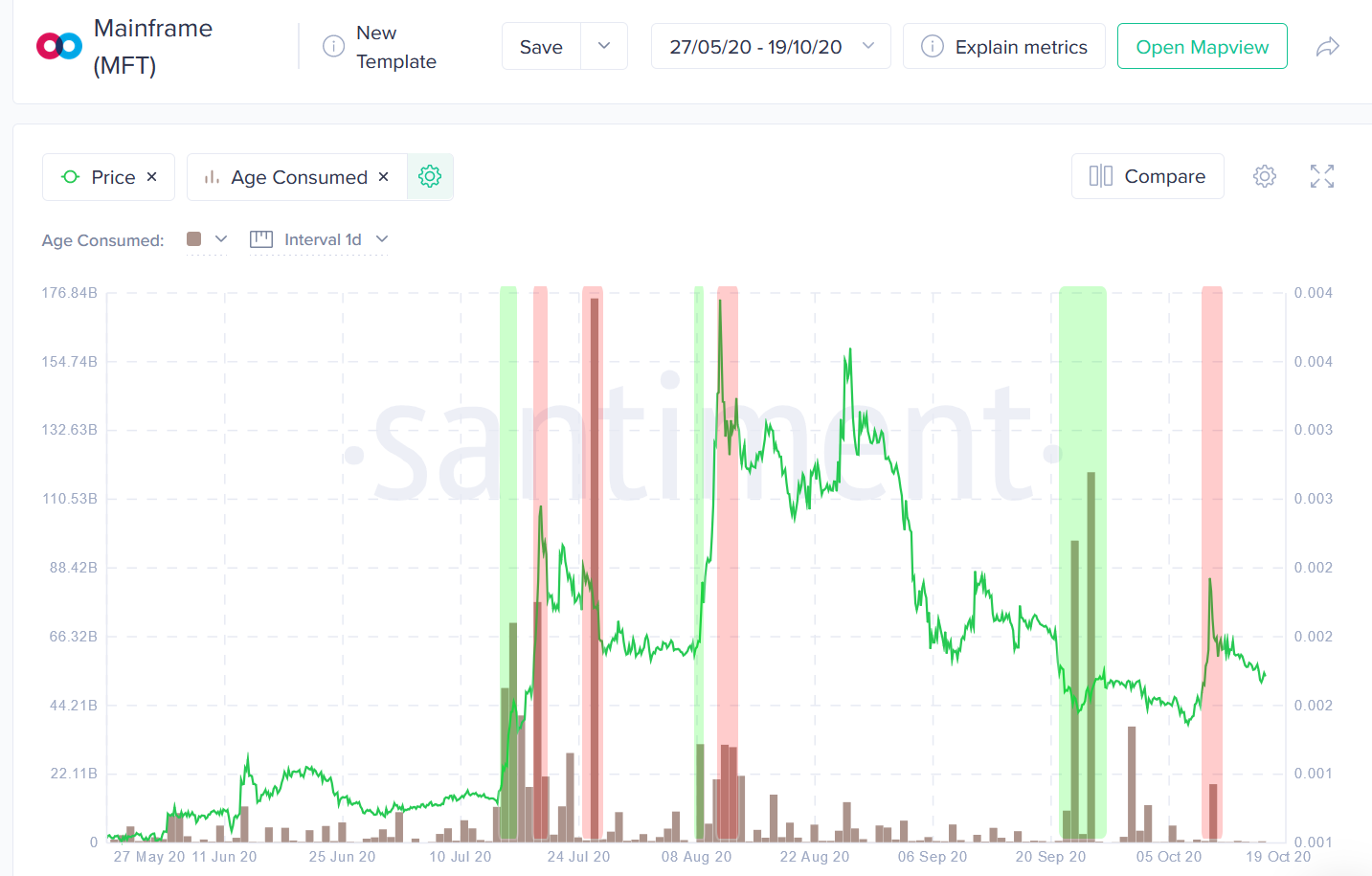
Timing future price volatility with Coin Age Consumed

Quick takeaways:
- Pronounced spikes in Coin Age Consumed often coincide with major shifts in market conditions and the coin’s short-term price action - in either direction
- Assets covered: BTC, ETH, REN, LINK, MKR, ANT, GNT
- Metrics included: Coin Age Consumed
When it comes to tracking shifts in the behavior of cryptocurrency HODLers and long-term investors, few metrics are as effective as Coin Age Consumed.
The premise behind the indicator is simple - HODLers and veteran traders rarely make rash decisions, and instead tend to move their coins or execute trades based on extensive analysis and/or intimate market knowledge.
Due to the above, renewed activity of long-term holders often coincides with major shifts in market conditions and the coin’s short-term price action.
To capture the above, Coin Age Consumed (also known as Coin Age Destroyed) is an on-chain metric that puts more onus on the coins that have remained idle (i.e. haven’t moved from their current address) for a long time, compared to those that were only acquired in the past several days or weeks.
Keep in mind that Age Consumed is neither a top or a bottom indicator: rather, it is a volatility marker. Spikes in Age Consumed point to a sudden, sharp rise in HODLers’ on-chain activity, and as such often precede directional changes in the coin’s price.
Case in point - Golem’s Age Consumed has recorded a number of major spikes over the past 90 days, all earmarking major trend reversals in GNT’s price action:

As you can see, significant Age Consumed spikes have been observed both at Golem’s local tops as well as several price bottoms during the past 3 months. When trying to understand the underlying behavior behind each Age Consumed uptick - and what that might mean for the coin’s price - proper market context is key.
For example, we can supplant Golem’s Age Consumed chart with the amount of GNT moving to exchanges daily for more information. When doing so, you can spot several major spikes in GNT’s exchange inflow, coinciding with its Age Consumed spikes near the coin’s price tops. This indicates a rising sell-side pressure originating from the coin’s long-term investors, which tends to reflect poorly on its short-term market performance:

On the other hand, Golem’s Age Consumed spike on October 7th - around its local bottom - lacked a corresponding uptick in the amount of GNT moving to exchanges, suggesting that the renewed HODLer activity was not sell-related, leaving room for a bounce back.
A similar pattern can be observed in a variety of altcoins, whose long-term holders can often have a disproportionate impact on the coin’s market action. For example, Mainframe’s Age Consumed chart over the past 5 months reveals major on-chain movements of long-term MFT investors coinciding with upcoming rallies, as well as a number of forming price tops and pending corrections:

It’s worth noting that this phenomenon is not reserved for low-cap altcoins either. For example, Maker’s native token (MKR) is another clear example that Age Consumed spikes can often serve as on-chain precursors of upcoming price volatility:

Frontlining the interoperability sector, REN’s Age Consumed often telegraphed upcoming price moves over the past 6 months, as the DeFi madness engulfed took over and rBTC became a household name:

Another popular DeFi-adjacent project, Aragon’s native token (ANT) had all three of its summer tops coinciding with major spikes in its Coin Age Consumed, suggesting strong profit-taking by some of the coin’s long term investors and leading to a swift trend reversal:

Finally and perhaps most importantly, significant spikes in Age Consumed can often signal an upcoming price volatility for two of the biggest, market-moving cryptocurrencies as well.
While Ethereum’s Age Consumed chart is significantly more noisy compared to $1m market cap coins, it still manages to reliably capture a number of its recent market ebbs and flows.
Ethereum’s largest Age Consumed spike in the previous 3 months was recorded on
September 1st - at ETH’s most recent price top of $481 - hours before the market-wide correction that erased much of the summer gains for hundreds of mid and low-cap coins.
On the other hand, Ethereum’s second largest Age Consumed spike in the past 3 months was recorded on September 23rd, almost precisely at Ethereum’s most recent bottom of $336:

As for the Big Kahuna itself, Bitcoin’s Age Consumed over the past 6 months has often successfully predicted the coin’s local price tops and periods of upcoming price consolidation.
During Bitcoin’s foray above $11000 between July 28th and September 3rd, Bitcoin’s Age Consumed recorded 3 pronounced spikes:
- On July 28th, right as BTC breached $11000 for the first time in 10 months, coinciding with the short-term discontinuation of Bitcoin’s price rally
- On August 17th, precisely at BTC’s most recent price top of $12,350
- On September 1st, right before the market-wide crash

Of course, there’s no such thing as a ‘silver bullet’ metric, and Age Consumed is no different. For one, it’s important to note that spikes in Age Consumed can sometimes be prompted by events wholly irrelevant to the coin’s price action, like the 24,000,000 LINK transfer from Binance’s cold to hot storage recorded on LINK’s age consumed chart:

This is why, rather than relying on Age Consumed in a vacuum, it’s always paramount to consult with other network and off-chain metrics, and do your own research before making any trading decisions. That said, checking Age Consumed for clues about the behavior of long-term investors can be a powerful way to track HODLer sentiment and time periods of high price volatility for the coin.
Want to give it a try? Check out Coin Age Consumed and dozens of other on-chain and fundametnal metrics live on Sanbase for 1000+ cryptocurrencies. Stay safe out there!